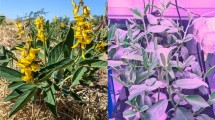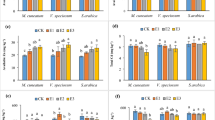Abstract
Contaminated soils and mine tailings pose major environmental and agricultural problems worldwide. These problems may be partially solved by an emerging new technology: phytoremediation. This technique uses plants to extract soil contaminants from the ground. Thlaspi caerulescens is known to accumulate in their tissues several heavy metals from soil and aerial deposition. This study was conducted to screen plants growing on a contaminated site to determine their potential for metal accumulation. Seeds of T. caerulescens metallicolous have been collected in the vicinity of F.T. Laurent le Minier in the Pb–Zn mining district of les Malines (North of Montpellier, Southern France), and seeds of T. caerulescens non-metallicolous were sampled on Larzac Plateau (North of Montpellier, Southern France). Soil substrates were collected from a mine site of Mibladen and Zaida (West, Morroco). Cultivated plant and surface soil samples were analyzed for zinc, lead, and cadmium concentrations by inductively coupled plasma mass spectrometry. A non-metallicolous (NM) ecotype of T. caerulescens and a metallicolous (M) ecotype are compared for Pb, Cd, and Zn accumulation in shoot and root in five metal-contaminated soils and one uncontaminated soil. The growth of individuals from uncontaminated soil was greater than that of individuals from metal-contaminated soils. The NM populations had markedly higher root/shoot ratio compared to M populations. The results indicate that both ecotypes of T. caerulescens are highly tolerant of zinc and Cd. Ecotype NM had constitutively higher Zn uptake capacity than the M ecotype. T. caerulescens species accumulate higher amount of Zn and Cd in their tissues in polluted soil and, in both of the two ecotypes, the root Pb concentrations were much greater than those of the shoot Pb contents. From both uncontaminated and metal-contaminated soils, we conclude that T. caerulescens are interesting material for phytoremediation of zinc and cadmium.





Similar content being viewed by others
References
Assunção AGL, DaCosta Martins P, De Folter S, Vooijs R, Schat H, Aarts MGM (2001) Elevated expression of metal transporter genes in three accessions of the metal hyperaccumulator Thlaspi caerulescens. Plant Cell Environ 24:217–226
Assunção AGL, Schat H, Aarts MGM (2003) Thlaspi caerulescens, an attractive model species to study heavy metal hyperaccumulation in plants. New Phytol 159:351–360
Baker AJM (1981) Accumulators and excluders—strategies in the response of plants to heavy metals. J Plant Nutr 3:643–654
Baker AJM, Brooks RR (1989) Terrestrial higher plants which hyperaccumulate metallic elements- a review of their distribution, ecology and phytochemistry. Biorecovery 1:81–126
Baker AJM, Walker PL (1990) Ecophysiology of metal uptake by tolerant plants. In: Shaw AJ (ed) Heavy metal tolerance in plants: evolutionary aspects. CRC, Boca Raton, USA, pp 155–177
Baker AJM, Reeves RD, Hajar ASM (1994) Heavy metal accumulation and tolerance in British populations of the metallophyte Thlaspi caerulescens J. & C. Presl (Brassicaceae). New Phytol 127:61–68
Bert V, Macnair MR, De Laguerie P, Saumitou-Laprade P, Petit D (2000) Zinc tolerance and accumulation in metallicolous and nonmetallicolous populations of Arabidopsis halleri (Brassicaceae). New Phytol 146:225–233
Bloemen ML, Markert B, Lieth H (1995) The distribution of Cd, Cu, Pb and Zn in topsoils of Osnabrück in relation to land use. Sci Total Environ 166:137–148
Brekken A, Steinnes E (2004) Seasonal concentrations of cadmium and zinc in native pasture plants: consequences for grazing animals. Sci Total Environ 326:181–195
Clemens S, Palmgren MG, Krämer U (2002) A long way ahead: understanding and engineering plant metal accumulation. Trends Plant Sci 7:309–319
Clemente R, Paredes C, Bernal MP (2007) A field experiment investigating the effects of olive husk and cow manure on heavy metal availability in a contaminated calcareous soil from Murcia (Spain). Agric Ecosyst Environ 118:319–326
Combe M, Simonot M (1971) La Haute Moulouya, le sillon d’Itzer-Enjil et le massif de Bou-Mia-Aouli. Notes et Mémoires du Service Géologique. Domaines du Rif et du Maroc oriental, Editions du service géologique du Maroc 231:193–201
Conesa H, Faz A, Arnaldos R (2007) Initial studies for the phytostabilization of a mine tailing from the Cartagena-La Union Mining District (SE Spain). Chemosphere 66:38–44
Dahmani-Muller H, van Oort F, Gelie B, Balabane M (2000) Strategies of heavy metal uptake by three plant species growing near a metal smelter. Environ Pollut 109:231–238
Dechamps C, Roosens N, Hotte C, Meerts P (2005) Growth and mineral element composition in two ecotypes of Thlaspi caerulescens on Cd contaminated soil. Plant Soil 273:327–335
Del Rio M, Font R, Moreno-Rojas R, De Haro-Bailon A (2006) Uptake of lead and zinc by wild plants growing on contaminated soils. Ind Crops Prod 24:230–237
Deram A, Denayer FO, Petit D, Van Haluwyn C (2006) Seasonal variations of cadmium and zinc in Arrhenatherum elatius, a perennial grass species from highly contaminated soils. Environ Pollut 140:62–70
Deram A, Denayer FO, Dubourgier HC, Douay D, Petit D, Van Haluwyn C (2007) Zinc and cadmium accumulation among and within populations of the pseudometalophytic species Arrhenatherum elatius: implications for phytoextraction. Sci Total Environ 372:372–381
Dudka S, Piotrowska M, Chlopeckca A, Witek T (1995) Trace metal contamination of soils and crop plants by the mining and smelting industry in Upper Silesia, South Poland. J Geochem Explor 5:237–250
Dudka S, Piotrowska M, Terelak H (1996) Transfer of cadmium, lead and zinc from industrially contaminated soil to crop plants: a field study. Environ Pollut 94:181–188
Ernst WHO, Verkleij JAC, Schat H (1992) Metal tolerance in plants. Acta Bot Neerl 41:229–248
Escarré J, Lefebvre C, Gruber W, Leblanc M, Lepart J, Rivière Y (2000) Zinc and cadmiumhyperaccumulation by Thlaspi caerulescens from metalliferous and nonmetalliferous sites in the Mediterranean area: implications for phytoremediation. New Phytol 145:429–437
Freitas H, Prasad MNV, Pratas J (2004) Plant community tolerant to trace elements growing on the degraded soils of Sao Domingos mine in the south east of Portugal: environmental implications. Environ Int 30:65–72
Gonzaga M, Santos I, Gonzaga JA, Lena Qiying M (2006) Arsenic phytoextraction and hyperaccumulation by fern species. Sci Agric 63:90–101
Gremion F (2003) Analysis of microbial community structures and functions in heavy metal-contaminated soils using molecular methods. Thèse de Doctorat, École Polythechnique Fédérale de Lausanne
Hall JL (2002) Cellular mechanisms for heavy metal detoxification and tolerance. J Exp Bot 53:1–11
Hall JL, Williams LE (2003) Transition metal transporters in plants. J Exp Bot 54:2601–2613
Hammond JP, Bowen HC, White PJ, Mills V, Pyke KA, Baker AJM, Whiting SN, May ST, Broadley MR (2005) A comparison of the Thlaspi caerulescens and Thlaspi arvense shoot transcriptomes. New Phytol 170:239–260
Kabata-Pendias A, Pendias H (1984) Trace elements in soils and plants. CRC, Boca Raton, FL
Keeling SM, Werren G (2005) Phytoremediation: the uptake of metals and metalloids by rhodes grass grown on metal-contaminated soil. Remediation J 15:253–261
Lasat MM, Baker AJM, Kochian LV (1996) Physiological characterization of root Zn2+ absorption and translocation to shoots in Zn hyperaccumulator and nonaccumulator species of Thlaspi. Plant Physiol 112:1715–1722
Lee JS, Chon HT (2003) Exposure assessment of heavy metals on abandoned metal mine areas by ingestion of soil, crop plant and groundwater. J Phys 107:757–760
Lee JS, Chon HT (2005) Risk assessment of heavy metals via exposure pathways of soil, water and crop plant in the abandoned metal mine sites. TP2 metals in the environment: regulatory and risk concerns
Li XD, Thornton I (1993) Multi-element contamination of soils and plants in old mining areas, U.K. Appl Geochem 2:51–56
Li XD, Thornton I (2001) Chemical partitioning of trace and major elements in soils contaminated by mining and smelting activities. Appl Geochem 16:1693–1706
Lloyd-Thomas DH (1995) Heavy metal hyperaccumulation by Thlaspi caerulescens J. & C. Presl. Ph.D. thesis, University of Sheffield, UK
Ma LQ, Komar KM, Tu C, Zhang W, Cai Y, Kennelly ED (2001) A fern that hyperaccumulates arsenic. Nature 409:579
Marmiroli M, Antonioli G, Maestri E, Marmiroli N (2005) Evidence of the involvement of plant ligno-cellulosic structure in the sequestration of Pb: an X-ray spectroscopy-based analysis. Environ Pollut 134:217–227
Mathe-Gaspar G, Anton A (2005) Study of phytoremediation by use of willow and rape. Acta Biol Szeged 49:73–74
Meerts P, Van Isacker N (1997) Heavy metal tolerance and accumulation in metallicolous and non-metallicolous populations of Thlaspi caerulescens from continental Europe. Plant Ecol 133:221–231
Meerts P, Duchene PH, Gruber W, Lefebvre C (2003) Metal accumulation and competitive ability in metallicolous and non-metallicolous Thlaspi caerulescens fed with different Zn salts. Plant Soil 249:1–8
Mulligan CN, Yong RN, Gibbs BF (2001) Heavy metal removal from sediments by biosurfactants. J Hazard Mater 85:111–125
Panfili F (2004) Etude de l’évolution de la spéciation du zinc dans la phase solide d’un sédiment de curage contaminé, induit par phytostabilisation. Thèse de Doctorat, Université de Provence—Aix-Marseille I, France.
Piñeros MA, Kochian LV (2003) Differences in whole-cell and single-channel ion currents across the plasma membrane of mesophyll cells from two closely related Thlaspi species. Plant Physiol, 131:583–594
Pence NS, Larsen PB, Ebbs SD, Letham DLD, Lasat MM, Garvin DF, Eide D, Kochian LV (2000) The molecular physiology of heavy metal transporter in the Zn/Cd hyperaccumulator Thlaspi caerulescens. Proceedings of the National Academy of Sciences of the United States of America 97:4956–4960
Pollard AJ, Baker AJM (1996) Quantitative genetics of zinc hyperaccumulation in Thlaspi caerulescens. New Phytol 132:113–118
Pollard AJ, Powell KD, Harper FA, Smith JAC (2002) The genetic basis of metal hyperaccumulation in plants. Crit Rev Plant Sci 21:539–566
Roosens N, Verbruggen N, Meerts P, Ximénez de Embùn P, Smith JAC (2003) Variation in cadmium tolerance and its relationship to metal hyperaccumulation for seven populations of Thlaspi caerulescens from Western Europe. Plant Cell Environment 26:1657–1672
Rosselli W, Keller C, Boschi K (2003) Phytoextraction capacity of trees growing on a metal-contaminated soil. Plant Soil 256:265–272
Saleh Al-Garni S (2006) Increased heavy metal tolerance of cowpea plants by dual inoculation of an arbuscular mycorrhizal fungi and nitrogen-fixer Rhizobium bacterium. Afr J Biotechnol 5:133–142
Stoltz E, Greger M (2002) Accumulation properties of As, Cd, Cu, Pb and Zn by four wetland plant species growing on submerged mine tailings. J Exp Bot 47:271–280
Tu C, Ma LQ (2002) Effects of arsenic concentrations and forms on arsenic uptake by the hyperaccumulator ladder brake. J Environ Qual 31:641–647
Wang M, Zou J, Duan X, Jiang W, Liu D (2007) Cadmium accumulation and its effects on metal uptake in maize (Zea mays L.). Bioresour Technol 98:82–88
White PJ, Whiting SN, Baker AJM, Broadley M (2002) Does zinc move apoplastically to the xylem in roots of Thlaspi caerulescens? New Phytol 153:199–211
Wong MH (2003) Ecological restoration of mine degraded soils, with emphasis on metal contaminated soils. Chemosphere 50:775–780
Yanai J, Zhao F, McGrath SP, Kosaki T (2006) Effect of soil characteristics on Cd uptake by the hyperaccumulator Thlaspi caerulescens. Environ Pollut 139:167–175
Yoon J, Cao X, Zhou O, Ma L (2006) Accumulation of Pb, Cu, and Zn in native plants growing on a contaminated Florida site. Sci Total Environ 368:456–464
Acknowledgment
This work was supported by the National Center of Scientific and Technological Research of (Morocco; CNRST) and by Laboratoire de Biochimie and Physiologie Moléculaire des Plantes (France). We thank José Escarré (Centre d’Ecologie Fonctionnelle et Evolutive, Montpellier, France) who kindly provided the seeds of T. caerulescens. We thank Pierre Berthomieu and Laurence Marques (Laboratoire de Biochimie and Physiologie Moléculaire des Plantes) for their advice and for sharing their knowledge, opinions, and literature
Author information
Authors and Affiliations
Corresponding author
Rights and permissions
About this article
Cite this article
El Kheir, S.B., Oubbih, J., Saidi, N. et al. Uptake and fixation of Zn, Pb, and Cd by Thlaspi caerulescens: application in the cases of old mines of Mibladen and Zaida (West of Morocco). Arab J Geosci 1, 87–95 (2008). https://doi.org/10.1007/s12517-008-0007-z
Received:
Accepted:
Published:
Issue Date:
DOI: https://doi.org/10.1007/s12517-008-0007-z




